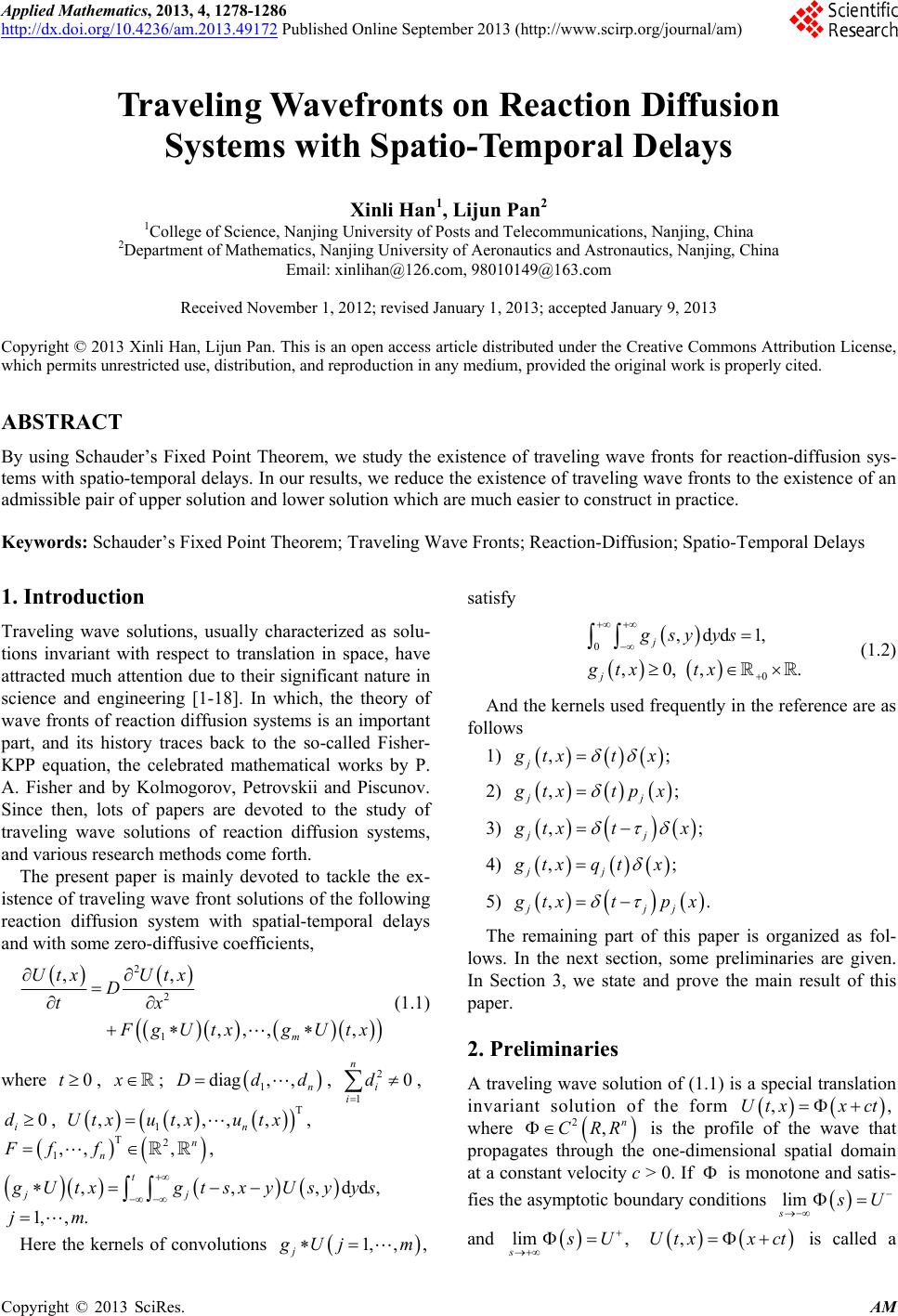 Applied Mathematics, 2013, 4, 1278-1286 http://dx.doi.org/10.4236/am.2013.49172 Published Online September 2013 (http://www.scirp.org/journal/am) Traveling Wavefronts on Reaction Diffusion Systems with Spatio-Temporal Delays Xinli Han1, Lijun Pan2 1College of Science, Nanjing University of Posts and Telecommunications, Nanjing, China 2Department of Mathematics, Nanjing University of Aeronautics and Astronautics, Nanjing, China Email: xinlihan@126.com, 98010149@163.com Received November 1, 2012; revised January 1, 2013; accepted January 9, 2013 Copyright © 2013 Xinli Han, Lijun Pan. This is an open access article distributed under the Creative Commons Attribution License, which permits unrestricted use, distribution, and reproduction in any medium, provided the original work is properly cited. ABSTRACT By using Schauder’s Fixed Point Theorem, we study the existence of traveling wave fronts for reaction-diffusion sys- tems with spatio-temporal delays. In our results, we reduce the existence of traveling wave fronts to the existence of an admissible pair of upper solution and lower solution which are much easier to construct in practice. Keywords: Schauder’s Fixed Point Theorem; Traveling Wave Fronts; Reaction-Diffusion; Spatio-Temporal Delays 1. Introduction Traveling wave solutions, usually characterized as solu- tions invariant with respect to translation in space, have attracted much attention due to their significant nature in science and engineering [1-18]. In which, the theory of wave fronts of reaction diffusion systems is an important part, and its history traces back to the so-called Fisher- KPP equation, the celebrated mathematical works by P. A. Fisher and by Kolmogorov, Petrovskii and Piscunov. Since then, lots of papers are devoted to the study of traveling wave solutions of reaction diffusion systems, and various research methods come forth. The present paper is mainly devoted to tackle the ex- istence of traveling wave front solutions of the following reaction diffusion system with spatial-temporal delays and with some zero-diffusive coefficients, 2 2 1 ,, ,,,, m Utx Utx D tx g U txgU tx (1.1) where , ; , 0tx 1 diag,, n Ddd2 1 0 n i i d , 0 i d Ff , , 1 ,,,,, n Utxu txutx T2 ,, , n f T 1n, ,, t jj ,dd, Utx gtsxyUsyys 1,,.jm Here the kernels of convolutions 1, ,, j Uj m satisfy 0 0 ,dd 1, ,0, , j j gsyys gtx tx . (1.2) And the kernels used frequently in the reference are as follows 1) ,; j txt x 2) ,; jj txt px 3) ,; jj tx tx 4) ,; jj txq tx 5) ,. jjj txtp x The remaining part of this paper is organized as fol- lows. In the next section, some preliminaries are given. In Section 3, we state and prove the main result of this paper. 2. Preliminaries A traveling wave solution of (1.1) is a special translation invariant solution of the form ,,Utxx ct where 2,n CRR is the profile of the wave that propagates through the one-dimensional spatial domain at a constant velocity c > 0. If is monotone and satis- fies the asymptotic boundary conditions lim s U and lim , s U ,Utx x ct is called a C opyright © 2013 SciRes. AM 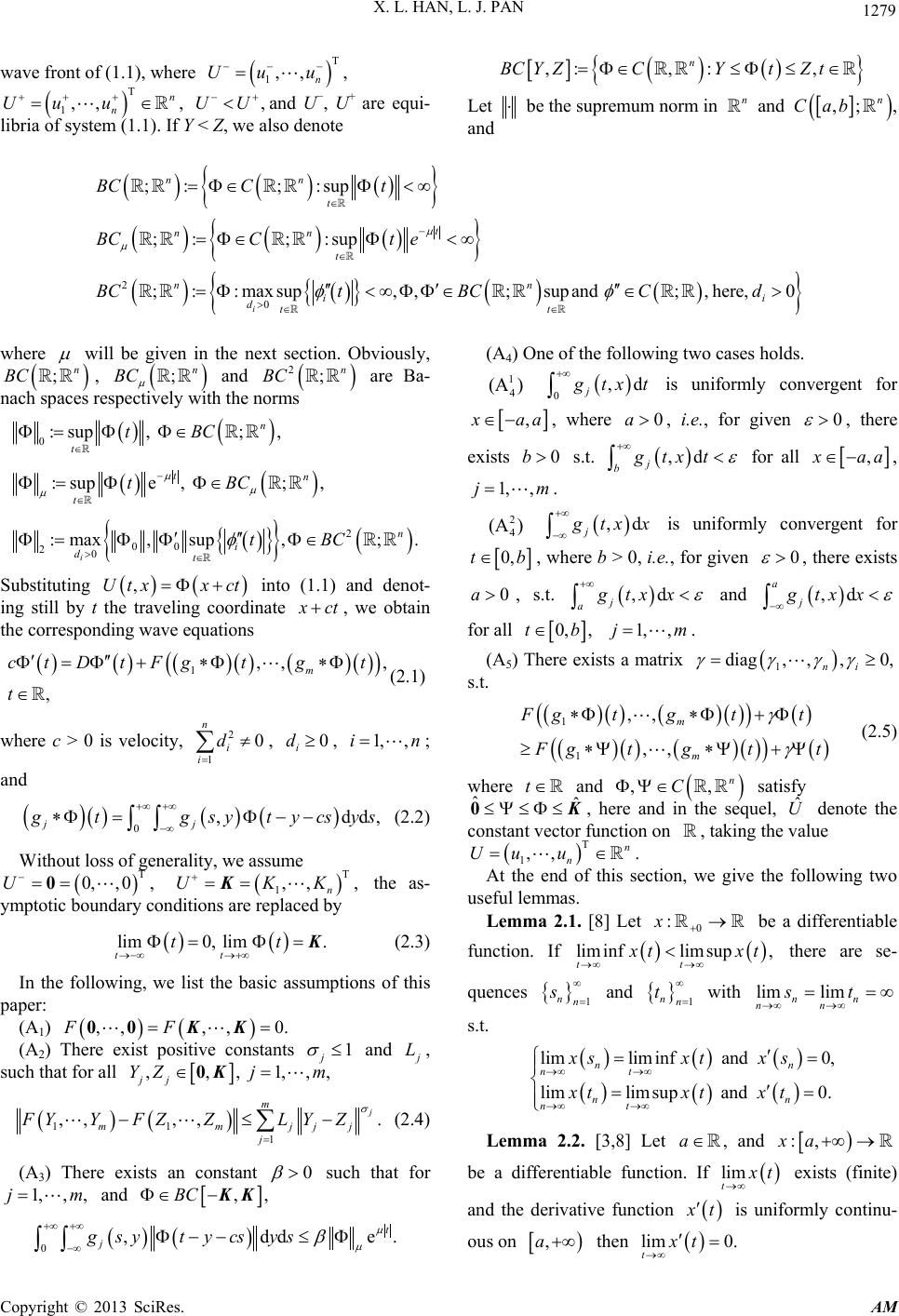 X. L. HAN, L. J. PAN 1279 wave front of (1.1), where T 1,, , n Uu u ,UU T 1,, n n Uu u , and U−, U+ are equi- libria of system (1.1). If Y < Z, we also denote ,:, :, n BC YZCYtZ t Let be the supremum norm in n and ,; n Cab, and 0 ;:su ;:s : max sup i nn t nn t i d C C t 2 ;: p ;: up ;:,,;supand ;,here,0 t nn i tt BC t BCt e BCBCC d where will be given in the next section. Obviously, , and are Ba- nach spaces respectively with the norms BC ;n ;n BC 2;n BC 0:sup, ;, n t tBC :supe, ;, tn t tBC 2 00 20 :max,sup,; . i n i dt tBC Substituting into (1.1) and denot- ing still by t the traveling coordinate ,Utxx ct ct, we obtain the corresponding wave equations 1,, , , m ctD tFgtgt t (2.1) where c > 0 is velocity, , , 2 1 0 n i i d 0 i d1, ,in ; and 0,d jj d, tgsytycs ys (2.2) Without loss of generality, we assume T 0,, 0,U0 the as- ymptotic boundary conditions are replaced by T 1,, , n UKK K lim0,lim. tt tt (2.3) In the following, we list the basic assumptions of this paper: (A1) . ,,,, 0FF00KK (A2) There exist positive constants 1 j and L, such that for all ,, jj YZ0, 1,, ,jm 11 1 ,, ,,. m mmjj j FYYFZZLYZ j (2.4) (A3) There exists an constant 0 such that for and 1,, ,jm ,,BC K 0,dd t j gsytycs ys (A4) One of the following two cases holds. 1 4 (A) 0,d j tx t is uniformly convergent for , aa , where , i.e., for given 0a0 , there exists s.t. 0 j b b ,dxtgt for all , aa , 1, ,jm . 2 4 (A) ,d j tx x is uniformly convergent for 0,tb, where b > 0, i.e., for given 0 , there exists , s.t. 0a j agtx,dx and ,dgtxx a j for all 0, ,tb1, ,jm . (A5) There exists a matrix s.t. 1 diag, ,,0, ni 1 1 ,, ,, m m gtg tt gtg t t (2.5) where t and satisfy ,, n C ˆˆ 0 , here and in the sequel, denote the constant vector function on , taking the value . ˆ U n 1,, T Uu u n At the end of this section, we give the following two useful lemmas. Lemma 2.1. [8] Let be a differentiable function. If 0 :x limsup t liminf , t t xt 1 n there are se- quences n s and 1 nn t with s.t. lim lim nn nn st limlim infand0, limlimsupand0. nn nt nn nt xsxtx s xtxtx t Lemma 2.2. [3,8] Let , and be a differentiable function. If li a t :,xa m t exists (finite) and the derivative function t is uniformly continu- e. ous on ,a then lim t xt 0. Copyright © 2013 SciRes. AM 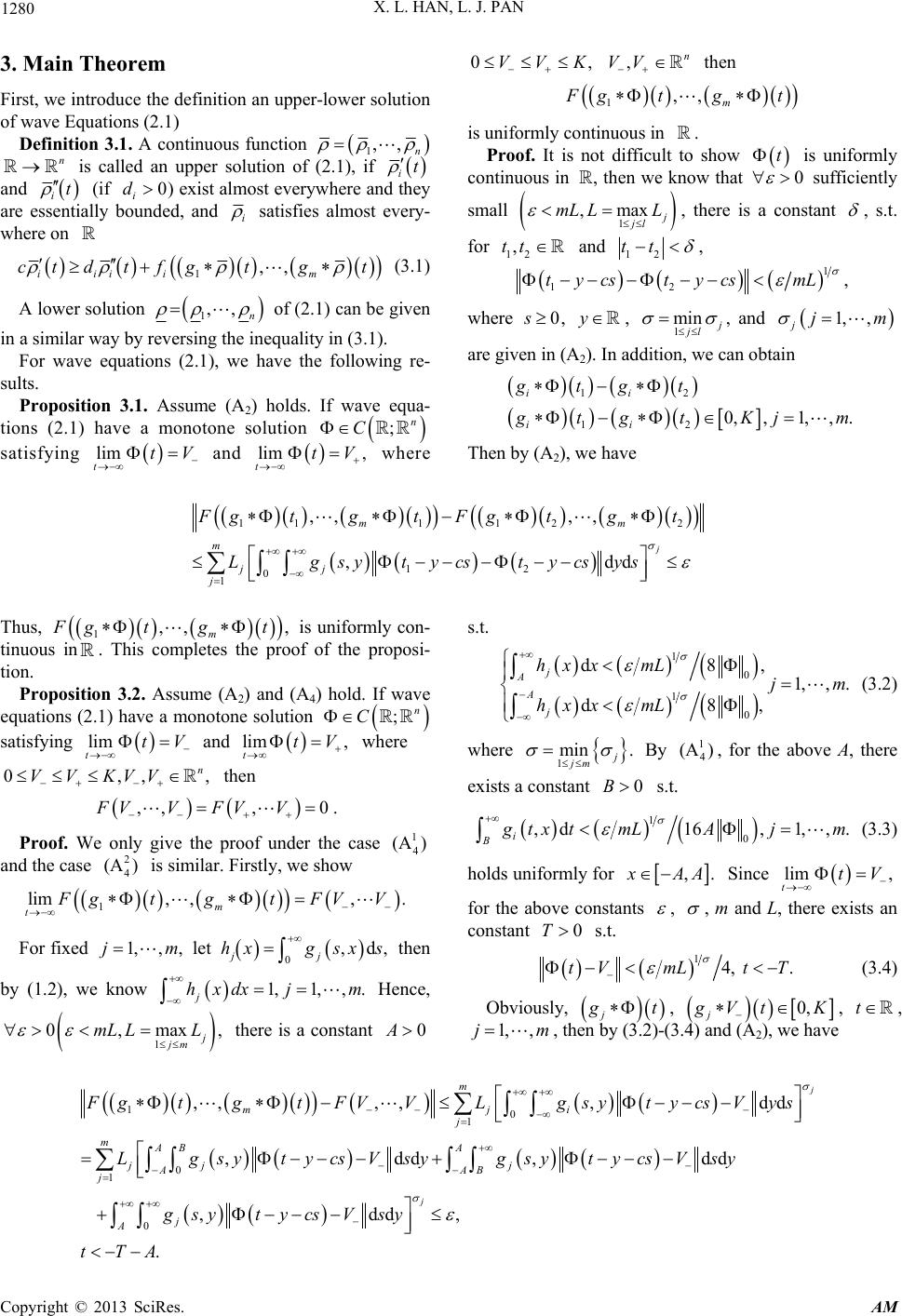 X. L. HAN, L. J. PAN 1280 3. Main Theorem First, we introduce the definition an upper-lower solution of wave Equations (2.1) Definition 3.1. A continuous function 1,, n n is called an upper solution of (2.1), if it and t (if 0d) ex iiist almost everyw e essentially bounded, and here and they ar i satisfies almost whe every- re on 1,, iiii m ctdtfgtgt (3.1) A lower solution 1,, n of (2.1) can be given in a similar way by reversing the inequality in (3.1) ns (2.1), we h . For wave equatioave the following re- sults. Proposition 3.1. Assume (A) holds. If wave e 2qua- tions (2.1) have a monotone solution ;n C satisfying lim ttV and lim , ttV where 0,VV K n then ,VV 1,, m gtg t is uniformly continuous in ow is uniformly . Proof. It is not difficult to sh continuous in , then we k t now that 0 sufficiently small 1 max , jl mL L , there is a cstant Lon , s.t. for 1 t2 ,t and 12 tt , 1 12 ,t y csy cstmL where 0 , y , 1 min jl , and n in2). In dition, we can obtain 1, , jjm are give (Aad 12ii tg t 12 0,,1,, . ii tg tKjm Then by (A2), we have 111 122 12 0 1 ,, ,, ,d j mm m jj j d gtg tFgtg t Lgsytycstycsys hus, , T 1,, m gtgt in. This completes the pro is uniformly con- position 3.2. Assume (A2) and (A4) hold. If wave eq tinuous of of the proposi- tion. Pro uations (2.1) have a monotone solution ;n C satisfying lim ttV and lim t,V where t 0,, n VV the ,KVV n ,, 0FV V . ,FV V Proof. We only give the proof under thase an e c1 4 (A) d the case 2 4 (A) is similar. Firstly, we show 1 lim, ,, m . t gtg tFV V For fixed let , then by Hence s.t. 1,, ,jm know 1 0, jm mL L 0,d jj hxg sx s 1, 1,,.dxjm , there is a constant (1.2), we , 0A j hx max j L 1 0 1 0 d8, 1,, . d8, j A A j hxxmL jm hxxmL (3.2) where 1 min . jm constant B By , for the above A, there 1 4 (A ) exists a0 s.t. 1 0 ,d16, 1,,. i B tx tmLAjm (3.3) holds uniformly for ,. AA Since lim , ttV ts for the above constan , , m and L, th ere exists an constant 0T s.t. 14, .tVmLt T (3.4) Obviously, j t , 0, j Vt K, t , 1, ,jm , th3. en by (3.2)-(4) and (A2), we have 10 1 0 1 0 ,, ,,,dd ,dd,dd ,dd, . j m mji j mAB A jj j AAB j j A gtgtFVVLgsytycsVys Lgsyty csVsygsyty csVsy gsytycs Vsy tTA Copyright © 2013 SciRes. AM 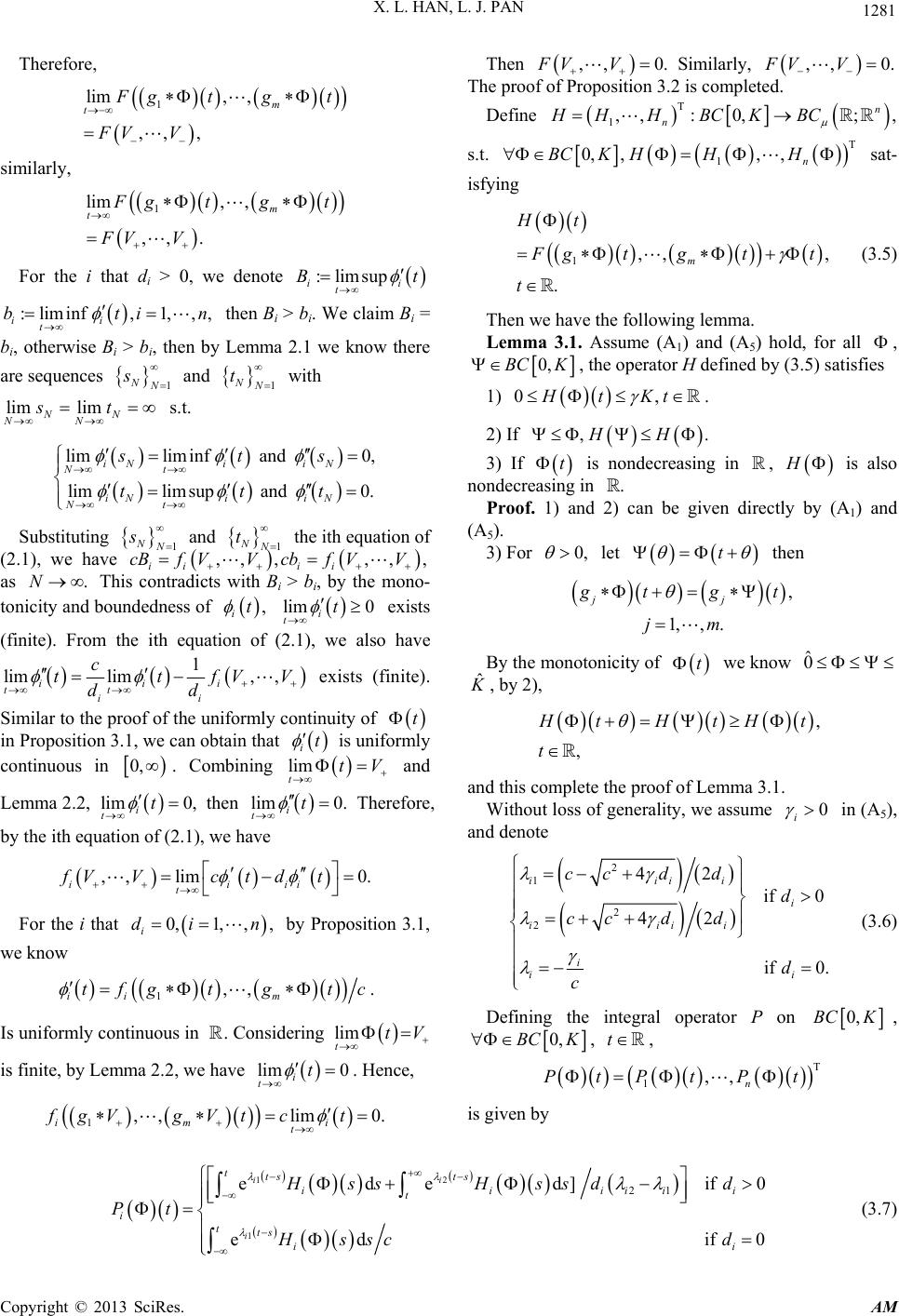 X. L. HAN, L. J. PAN 1281 Therefore, 1 lim, , ,, , m t gtg t FV V similarly, 1 lim, , ,, . m t gtg t V V F For the i that di > 0, we denote :limsup i t Bt i > bi. We claim Bi = .1 we know there with :liminf,1,, , ii t bti Bi > bi, then by are sequences 1 NN s and lim lim NN NN st s.t. n then Bi Lemma 2bi, otherwise 1 NN t limliminf and and 0. iN i Nt i iN st tt Substituting 1 NN s and 1 NN t the ith equation of (2.1), we have , i ii f Vcbf ness o 0, lim limsup iN iN Nt s t as tonicity and boundedf exists (finite). From the ith equat have i cB This contradicts with , ,V Bi ,, ,V V > bi, by the mono- .N , it ion of lim 0 i tt (2.1), we also ,VV exists (fi 1 lim lim ii tt ii c tt dd nite). Sioof of trmly c , i f milar to the prhe unifoontinuity of t in Proposition 3.1, we can obtain that it is uniformly tt continuous in . Combining 0, lim V t en t and Lemma 2.2, lim 0, i t therefore, by the ith equation of (2.1), we have 0.t lim t0. i Th ,, lim iiii t fVVct d For the i that 0,1, ,, i di n by Propositio we know n 3.1, 1,, ii m tfgt gtc . ering Is uniformly continuous in . Consid lim ttV 0. Hence, is finite, by Lemma 2.2, we ve ha lim i tt ,,lim 0.fgVgVt ct 1im i t ,, 0FV V Then . Similarly, ,, 0.FV V ted. The pro2 is comple Define of of Proposition 3. T 1,,:0,; n n HHHBCK BC T 1 0,,,, n BCK HHH sat- , s.t. isfying , Ht 1,, . m gtt t ) g t (3.5 Then we have the following lemma. Lemma 3.1. Assume (A1) and (A5) hold, for all , 0,BC K , the operator H defined by (3.5) satisfi 1) es 0,HtKt . ,.HH 2) If 3) If t is nondecreasing in , H is also nondecreasi Proof. 1) and 2) can be given directly by (A1) and (A5). 3) For ng in . let t 0, then , 1,, . jj tg jm t By the monotonicity of t we know ˆ 0 ˆ , by 2), , , tHtHt t and this complete the proof of Lemma 3.1. Without loss of generality, we assume 0 i in (A5), and denote 2 1 2 2 42 if 0 42 if 0. iiii i iiii i ii ccd d d ccd d d c (3.6) Defining the integral operator P on 0,BCK , 0,BC K , t , is given by 1,, n PtPtPt T 12 1 21 eded] if ed if ii i tts ts iiiii t i tts i i Hss Hssdd Pt Hssc d 0 0 i (3.7) Copyright © 2013 SciRes. AM 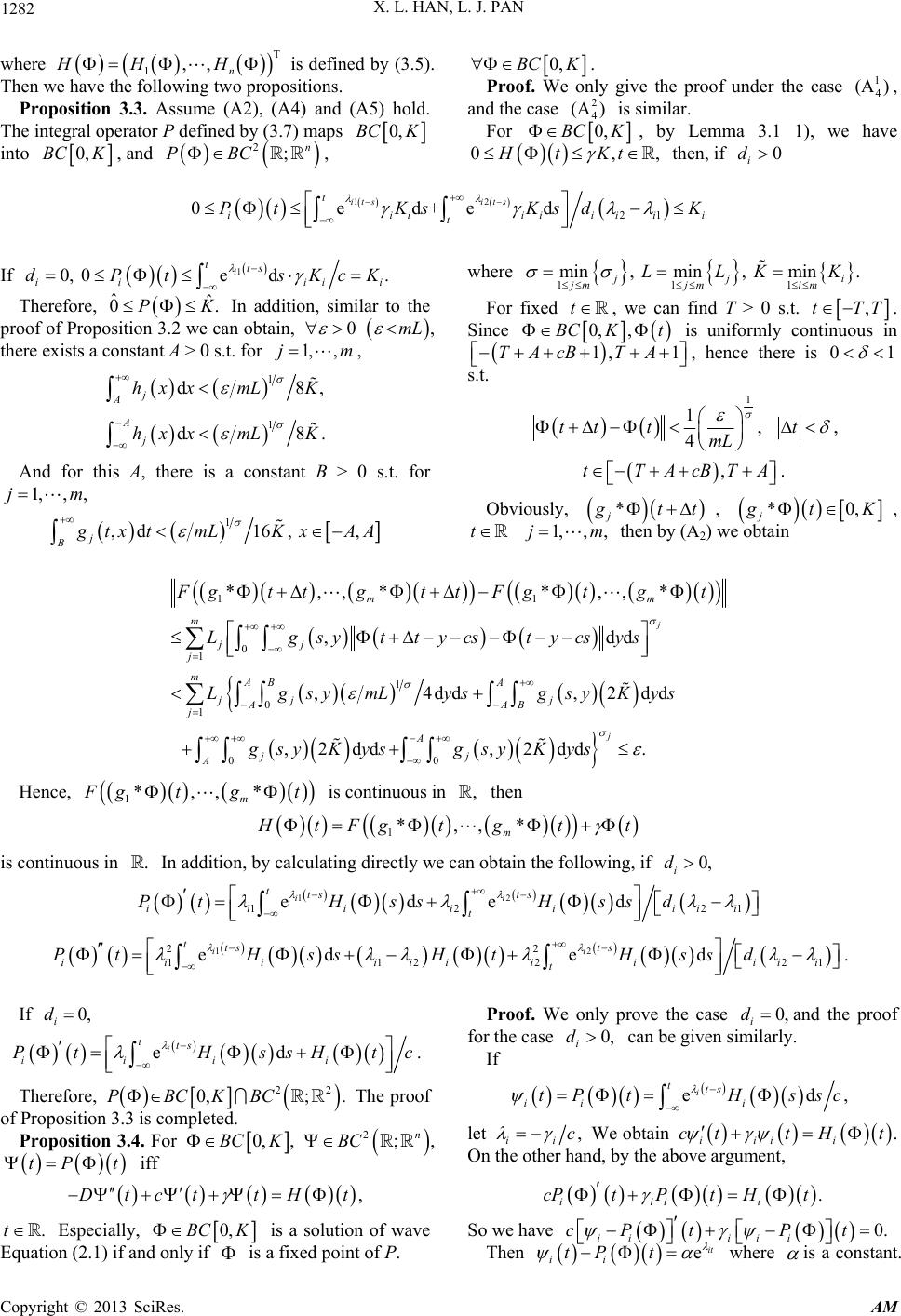 X. L. HAN, L. J. PAN 1282 w defined by (3.5 tion 3.3. Assume (A2), (A4) and (A5) hold The integral operator P defined by (3.7) maps here T 1,n H H is). Then we have the following two propositions. ,H Proposi . 0,BCK , and , 2;n PBC 0,BC K . Proof. We on and the case 2 4 (A ly give the proof under th case is similar. into 0,BC K e 1 4 (A) , ) For 0,BC K , byma 3.1 1 Lem), we have ,HtKt 0, thif 0 i d en, 12 21 0ed+ed itsits t iiiiiii t PtKsKs dK ii If 0, i d 1 0ed i tts ii Pt sKcK . ii on, similar to the pr Therefore, 0.PK In additi ˆˆ oof of Proposition 3.2 we can obtain, 0 m, its a onstant A > 0 s.t. for 1, ,jm, L there exsc 1 d8 j Ahxx ,L K m 1 d8 A j hxxmLK . nB > 0And for this A, there is a constat s.t. for jm1,, , 1 ,d16, , j B txtmLK xAA where 1 in . 11 min, min, m ji jm jm For fixed im K LLK , we can find T > 0 s.t. ,tTT. t Since 0,BCK,t is uniformly co ntinuous in 1,cB 1TA TA , hence there is 01 s.t. 1 1, 4 tt tmL t , ,tTAcBTA . Obviously, * j tt , *0 j, tK , t 1,, ,jm then by (A2) we obtain 0 ,2 dd A j A 11 0 1 1 0 1 0 *,,* ,,* ,dd ,4dd,2 dd j j mm m jj j mAB A jj j AAB j j ,2dd. *gttg tttg t Lgsytt ycst ycsys Lg symLysg syKys g Fg gsyKys sy Kys Hence, 1*,,* m gtgt is continuous in , then 1*,,* m tFg t gtt is continuous in In addition, by calculating directly we can obtain the following, if . 0, i d 12 12 eded ii tts ts iiii iii t PtHss Hssd 21 i 1 2 2 2 1122 ed ed i i tts ts iii iiiiiii t PtHss H21 i Hssd . t If 0, i d ed i tts iiii Pt HssHtc . Therefore, 22 0,; .PBCKBC 3.3 is completed. The proof of Proposition Proposition 3.4. For 0,BC K , 2;n BC , tP t iff ,DtcttH t .t Especially, 0,BC K only if is a solution of wave if and a fixed point of P. f. We only prove t case can be g Equation (2.1) is Proo he case 0, i dand the proof for theiven similarly. If 0, i d ed,c i tts ii i tP tHss let , ii c We obtain . iii i ctH t bove argument t , On the other hand, by the a So we have ii i cPtPtH . it 0. ii iii cPtP t Then eit ii tPt where is a constant. Copyright © 2013 SciRes. AM 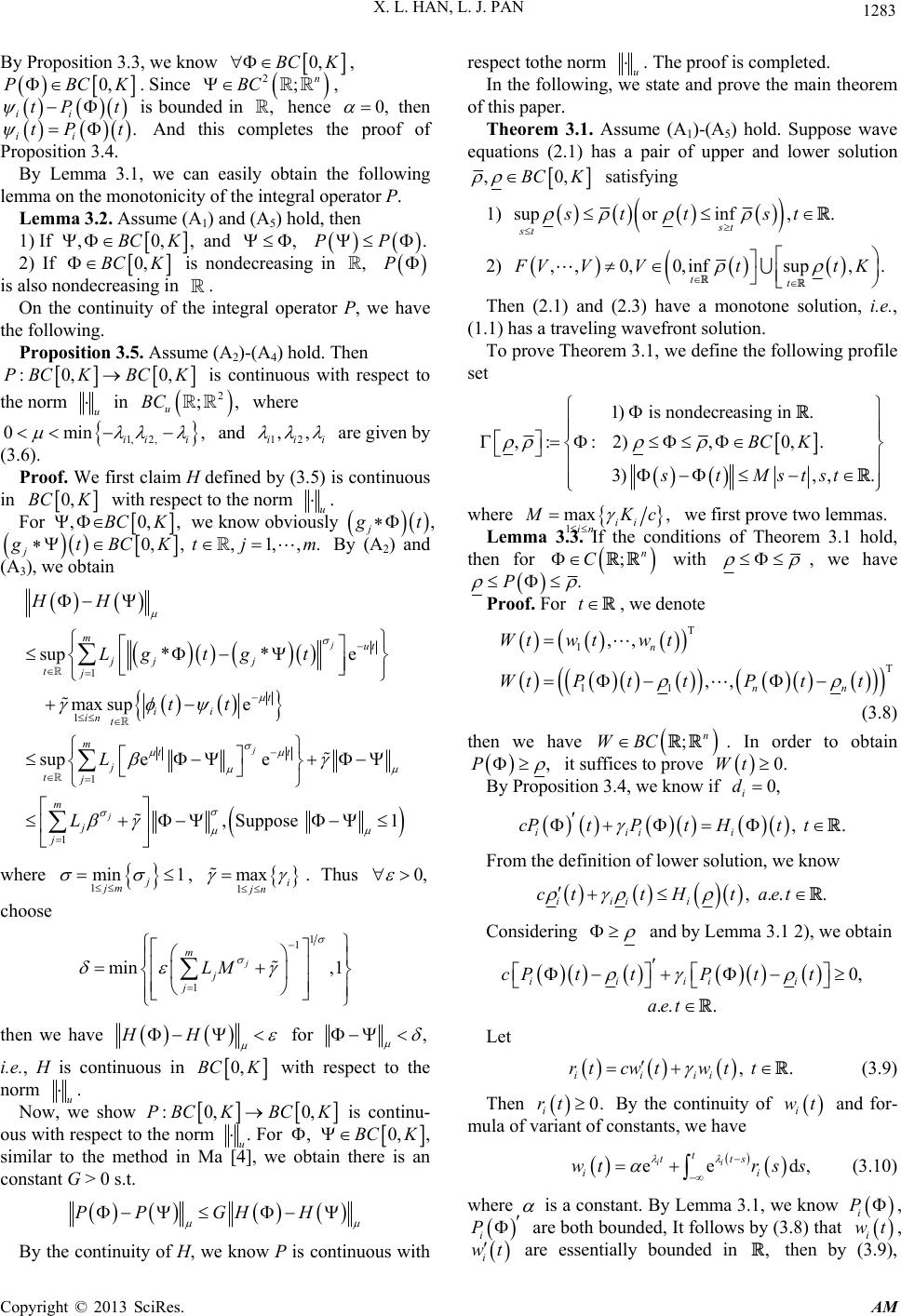 X. L. HAN, L. J. PAN 1283 0,BC K By Proposition 3.3, we know , 0,PBC ii tP t K. Since is bou 2;n BC , d in , hence nde 0, then And thproof of By Lemma 3.1, we ca following lemma on the monotonicity oor P. Lemma 3.2. Assume (A1 1) If . ii tPt Proposition 3.4. is completes the n easily obtain the f the integral operat ) and (A5) hold, then ,0,BC K ,d , an .PP 2) If 0,BC K isin , nondecreasing P is also . On the continuity of the i, we have 5. Ass nondecreasing in ntegral operator P 2)-(A4) hold. Then the following. Proposition 3.ume (A :0, 0,PBCKBC K the norm is continuous with respect to u in BC ;, where , 2 u 1, 2, 0min iii and 12 ,, ii i are defined by (3.5) is c given by oof. We first claim H ontinuous in (3.6). Pr 0,CK Bwith respect to the norm u . For ,0,BCK , we know obvly ious j t , 0,, ,1,,. j tBCK t jm (A By (A2) and 3), we obtain 1 1 sup* e e ,Suppose j j mut jj j tj m j j Lg tg t tt L 1 max sup t ii in t 1 sup ee j mtt j tj L * 1 HH re whe 11 j jm , 1i jn min max . Thus 0, choose 1 1 1 min ,1 j m j j LM then we have HH for , i.e., H is continuous in 0,BCK with respect to the norm u . Now, we show :0, 0, BC KBC K is continu- ous with respect to the norm u . For , 0,BC K , sim e is ilar to the method in Ma [4], we obtain ther G > 0 s.t. an constant PP GHH , we ow P is continuous with respect tothe norm By the continuity of Hkn u . The proof is completed. In the following, we state and prove the main theorem of this paper. Theorem 3.1. Assume (A1)-(A5) hold. Suppose wave equations (2.1) has a pair of uppnd lower solution er a ,0,BC K satisfying 1) suporinf, . st st st tst 2) , ,0,0,infsup,. tt VV VttK Then (2.1) and (2.3have a monotone solution, i.e., front sotion. we define the following profile set ) (1.1) has a traveling wavelu To prove Theorem 3.1, 1) is nondecreasing in . ,: :2),0,. 3), ,. BC K stMstst where 1ii in max , Kc we first prove two lemmas. hold, then for Lemma 3.3. If the conditions of Theorem 3.1 ;n C with , we have .P Proof. For t , we denote ,, n twtw t Wt t 1 T 11 ,, n n P ttPt T W (3.8) then we have ;n WBC . In order to obtain ,P it suffices to prove 0.Wt 0, i d By Proposition 3.4, we know if , iii i cPtPtHtt From the definition of lower solution, we know , ... iii i cttH taet and by Lemma 3.1 2), we obtain Considering 0, .. . iiiii cP ttP tt ae t Let .t , iiii rtcwwt t ) Then (3.9 0. i rt riant of c By the continuity of and for- mula of vaonstants, we have d, (3.10) i wt ee i itts t ii wtrss where is a c.1, we k i P onstant. By Lemma 3now , P i are both by (3.8 i wt bounded, It follows) that , i wt are essentially bo , then by (3.9), unded in Copyright © 2013 SciRes. AM 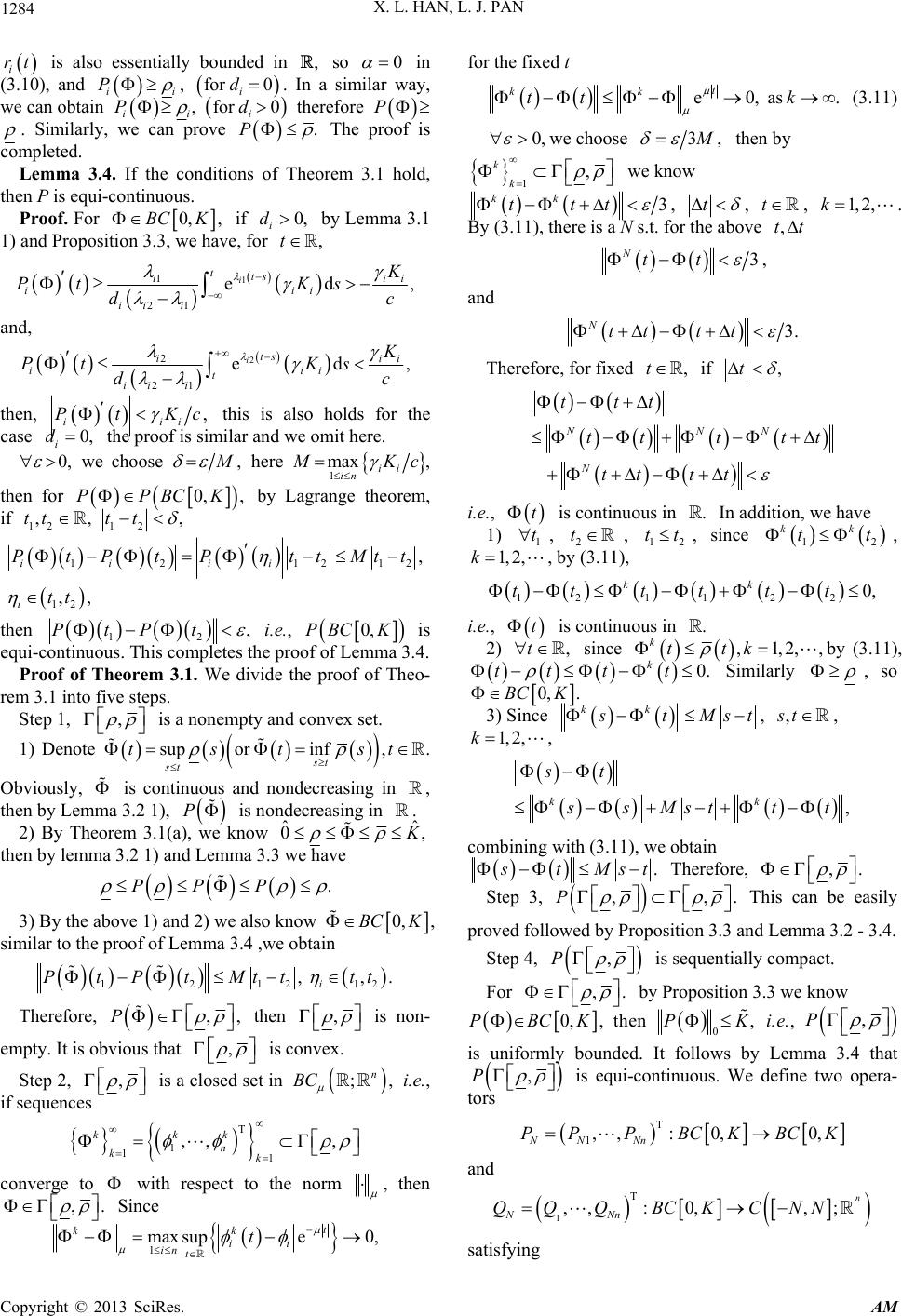 X. L. HAN, L. J. PAN 1284 i rt also is essentially bounded in so, 0 in (3.10), and ii P for 0 i d . In a , similar way, we can obtain ii P , fo 0 i rd therefore P . Similarly, we can prove .P The proof is completed. L then emma 3.4. If the corem P is equi-continuous. nditions of T heo 3.1 hold, Proof. For 0, ,BC K if 0, i d by Lemma 3.1 1) and Proposition 3.we have, for ,t 3, 1 1ed, i tts iii i 21ii i ii Pt Ks dc and, 2 21 its i 2i ted, i i iii ii Pt Ks c d then, , i Kc this is also ilar an ii Pt holds for the the proof is simmit here. case 0, i d d we o 0, we choose , here 1 max ii in Kc en for , th 0, ,PPBCK by Lagrange theorem, if 121 2 ,, ,tttt 1 212 12 , ,, i i tPtP tMtt tt then 12ii t i P 12 ,PtPt i.e., 0,PBCK f Lemma is equi-continuous. This comple 3.4. Proof of Theorem 3.1. Weroof of Theo- into five steps. tes the proof o divide the p rem 3.1 Step 1, , is a nonempty and convex set. 1) Denote or ,st sup st ts inf st t Ois cng in then by Lem 3.2 1), reasing in 2) By Them 3.1(a) is nondec know . bviously, ontinuous and nondecreasi ma ore , . P , we ˆˆ 0, then by lemma 3.2 1) and Lemma 3.3 we have .PPP nd 2) we al3) By the above 1) aso know 0,BC K , sie proof of Lemma 3.4milar to th ,we obtain 121i PtPtMt 212 ,,.t tt Therefore, ,,P then , is non- empty. It is obvious that , is convex. Step 2, , is a closed set in i.e., if seque ;, n BC nces T 1 11 ,, , kkk n kk converge to with respect to the norm , then ,. Since 1 max supe0, t kk ii int t for the fixed t e0, as. t kk t t k (3.11) 0, we choose 3, then by 1, k k we know 3 kk ttt , t , t, k1, 2, . 1), there is a N s.t. for the above ,tt By (3.1 3 Ntt , and 3. Ntt tt Therefore, for fixed ,t if ,t NN tt t tt ttt N Ntt tt i.e., t t is continuous in In addition, we have . 1) 1 , 2 t , 12 tt , sin 12 kk ttce , 1,k2, , by (3.11), 1211 22 0, kk ttttt t i.e., t t is continuous in . 2) , since ,1,2,, kttk by (3.11), 0. ktt t t Similarly , so 0,BC 3 .K ) Since kk tMst , ,st, k, 1, 2, , kk st sMsttt combining with (3.11), we obtain . tMst Therefore, ,. Step 3, ,,.P This can be easily pr lowed by.4. oved fol Proposition 3.3 and Lemma 3.2 - 3 Step 4, ,P is sequentially compact. For ,. by Proposition 3.3 we know 0, ,PBCK then 0,K i.e., P P, 3.4 thatis uniformly bounded. It follows by Lemma ,P us.wo opera- tors and satisfying is equi-continuo We define t T 1,,: 0, NN Nn PPP BCKBC 0,K T ,,:0,, ; n Nn QQQ BCKCNN 1 N Copyright © 2013 SciRes. AM 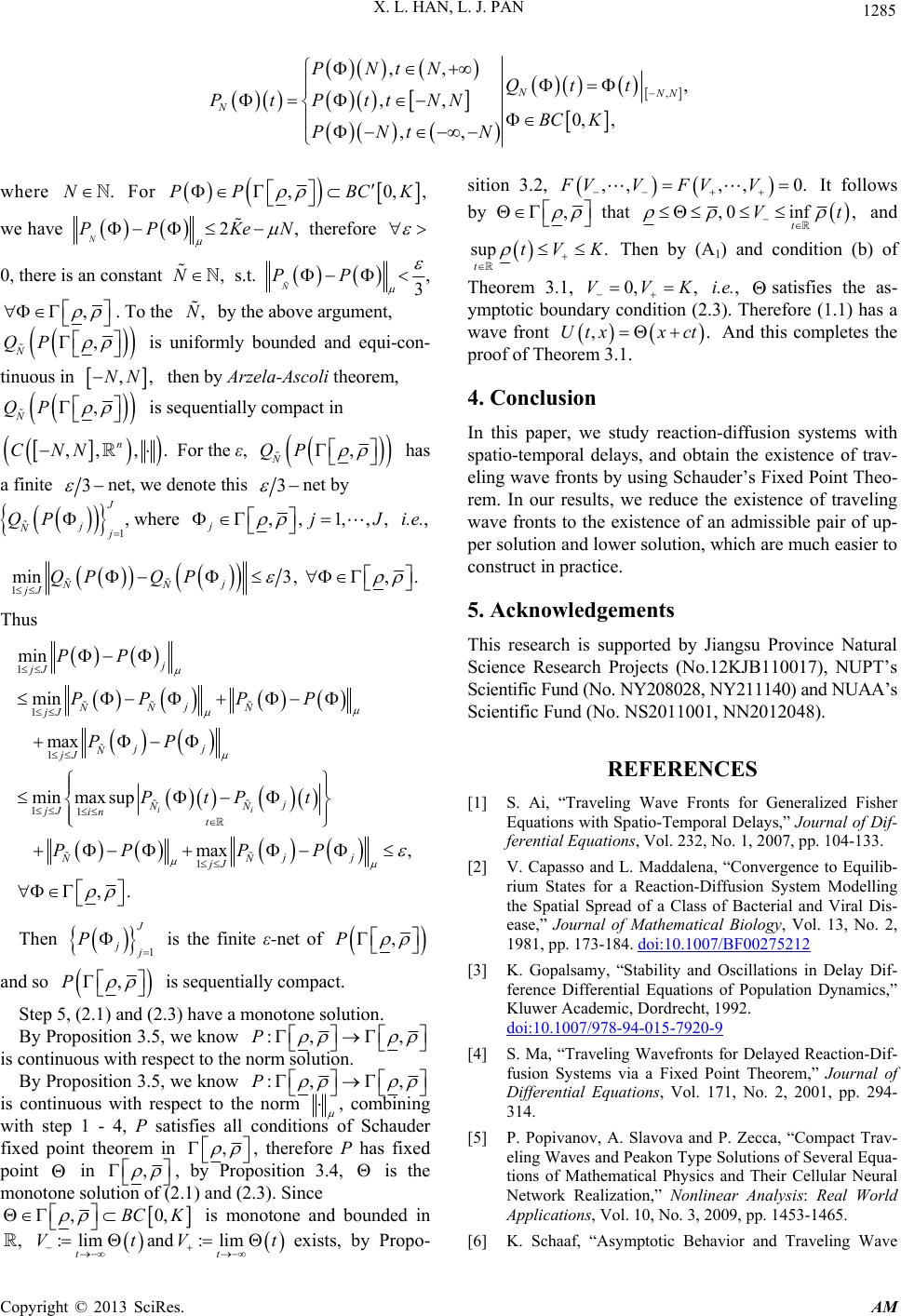 X. L. HAN, L. J. PAN Copyright © 2013 SciRes. AM 1285 ,, , ,, ,, N NtN Qtt Ptt N BC PNt N P ,NN N Pt N 0, ,K where NFor . ,0,,PPBK ,,,,0.FVV FVV C we have 2, N PP Ke N therefore 0, there is an constant s.t. ,N 3 N PP , , . To the by the above argume,N nt, , N QP is uormly bounded and equi-con- tinuous in nif ,,NN tela-Ascoli thhen by Arz eorem, , N QP compact in is sequentially ,, ,. n CNN For the ε, N QP , has a finite 3 net, we denote this 3 net by 1 j N Q P , where ,, 1,, jjJ , i.e., 1 min3, ,. j NN jJQP QP Thus 1 1 1 11 1 min min max min m max , ,. ii j jJ j NN N jJ jJ j NN jJ in t jj NN jJ PP PP PP P t PPP P ax supPt jj N PP Then 1 j P is the finite ε-net of ,P and so ,P is sequentially co ) haveotone solution. By Proposition 3.5, we know mpact. Step 5, (2.1) and (2.3 a mon :, ,P is continuous with respect to By Proposition the norm solution. 3.5, we know :, ,P is continuous norm with respect to the , combining with step 1 -all conditions of Schaude 4, P satisfies r fixed point theorem in , , therefore P has fixed point in , , by Proposition 3.4, is the m solution of ). Since onotone(2.1) and (2.3 ,0,BC K is monot bo , and :limVtV xists, by one andunded in te Propo- sition 3.2, It follows by ,0inf , t Vt :lim tt , that and sup . t tVK Then by (A1) and condition (b) of Theorem 3.1, 0, ,VVK i.e., satisfies the as- efore (1.1) has a Therymptotic boundary condition (2.3). wave front ,.Utxx ct And this completes the proof of Th Iner, we studs with spatio-temporal delayrav- elave fronts by eo- rem. In our results, we reduce the existence of traveling tion ct in practice. 5. Acknowledgements search is supported by Jiangsu Province Natural Science Research Projects (No.12KJB110017), NUPT’ Scientific Fund (No. NY208028, NY211140) and NUAA’s und (No. NS2011001, NN2012048). REFERENCES [1] S. Ai, “Traveling Wave Fronts for Generalized Fisher Equations with Spatio-Temporal Delays,” Journal of Dif- ferential Equations, Vol. 232, No. 1, 2007, pp. 104-133. [2] V. Capasso and L. Maddalena, “Convergence to Equilib- rium States for a Reaction-Diffusion System Modelling the Spatial Spread of a Class of Bacterial and Viral Dis- ease,” Journal othematical Biology, Vol. 13, No. 1981, pp. 17i:10.1007/BF00275212 eorem 3.1. 4. Conclusion this papy reaction-diffusion system s, and obtain the existence of t ing wusing Schauder’s Fixed Point Th wave fronts to the existence of an admissible pair of up- per soluand lower solution, which are much easier to constru This re s Scientific F f Ma 2, 3-184. do [3] K. Gopalsamy, “Stability and Oscillations in Delay Dif- ference Differential Equations of Population Dynamics,” Kluwer Academic, Dordrecht, 1992. :10.1007/978-94-015-7920-9doi eling Wavefronts for Delayed Reaction-Dif- fusion Systems via a Fixed Point Theorem,” Journal of Differential Equations, Vol. 171, No. 2, 2001, pp. 294- 314. [5] P. Popivanov, A. Slavova and P. Zecca, “Compact Trav- eling Waves and Peakon Type Solutions of Several Equa- tions of Mathematical Physics and Their Cellular Neural Network Realization,” Nonlinear Analysis: Real World Applications, Vol. 10, No. 3, 2009, pp. 1453-1465. [6] K. Schaaf, “Asymptotic Behavior and Traveling Wave [4] S. Ma, “Trav 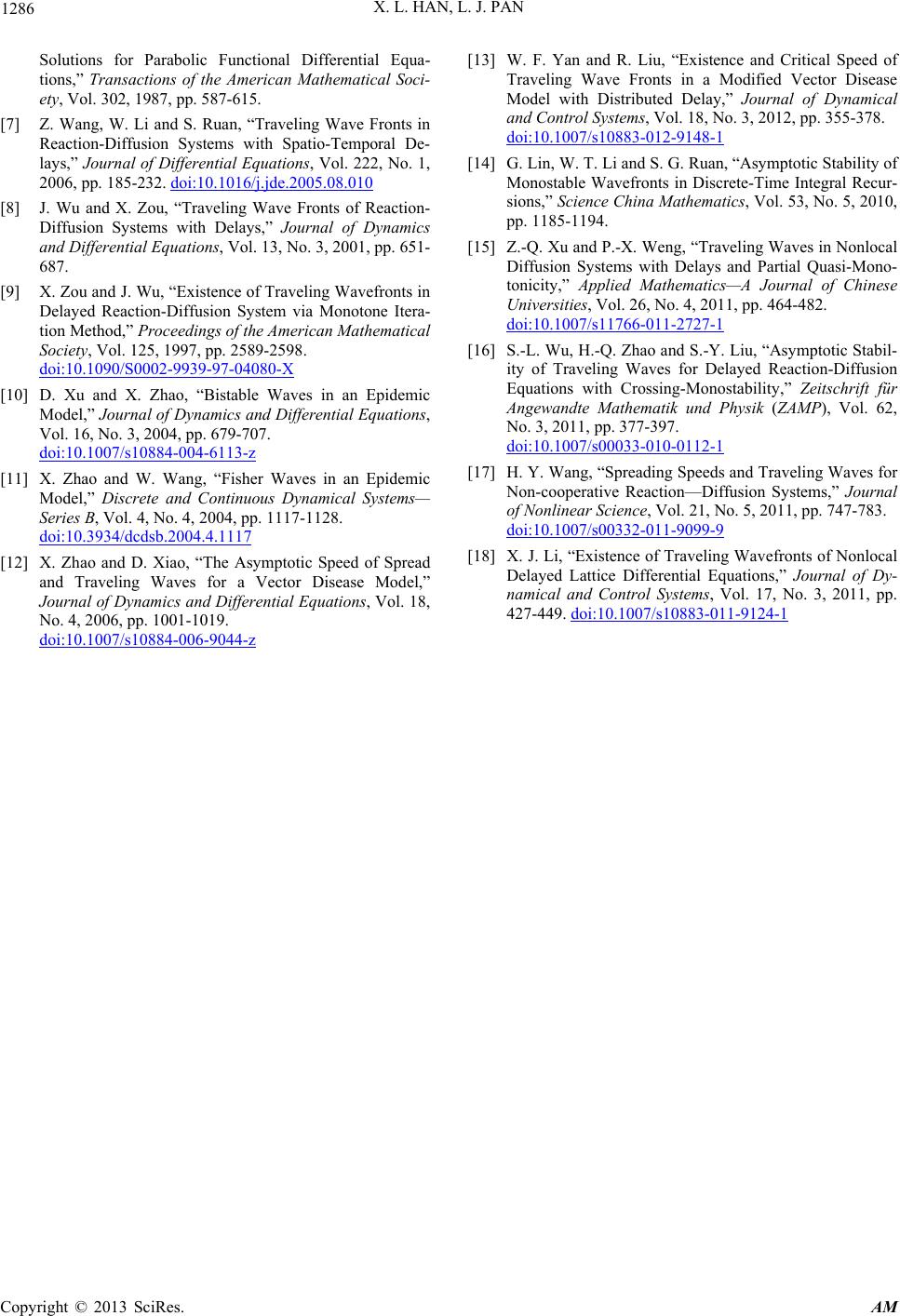 X. L. HAN, L. J. PAN 1286 Solutions for Parabolic Functional Differential Equa- tions,” Transactions of the American Mathematical Soci- ety, Vol. 302, 1987, pp. 587-615. [7] Z. Wang, W. Li and S. Ruan, “Traveling Wave Fronts in Reaction-Diffusion Systems with Spatio-Temporal De- lays,” Journal of Differential Equations, Vol. 222, No. 1 2006, pp. 185-232. doi:10.1016/j.jde.2005.08.010 [13] W. F. Yan an Critical Speed of Traveling Wave Fronts in a Modified Vector Disease , [8] J. Wu and X. Zou, “Traveling Wave Fronts of Reaction- Diffusion Systems with Delays,” Journal of Dynamics and Differential Equations, Vol. 13, No. 3, 2001, pp. 651- 687. [9] X. Zou and J. Wu, “Existence of Traveling Wavefronts in Delayed Reaction-Diffusion System via Monotone Itera- tion Method,” Proceedings of the American Mathematica ety, Vol. 125 doi:10.1090/S0002-9939-97-04080-X l Soci , 1997, pp. 2589-2598. Xu and X. Z Epidemic z [10] D. hao, “Bistable Waves in an , Model,” Journal of Dynamics and Differential Equations Vol. 16, No. 3, 2004, pp. 679-707. doi:10.1007/s10884-004-6113- ous Dynamical Systems— [11] X. Zhao and W. Wang, “Fisher Waves in an Epidemic Model,” Discrete and Continu Series B, Vol. 4, No. 4, 2004, pp. 1117-1128. doi:10.3934/dcdsb.2004.4.1117 [12] X. Zhao and D. Xiaoymptotic Speed of Spread and Travelingves for a Vector DiseasModel,” Journal of Dynamics and Differential Equation. 18, , “The As Wae s, Vol No. 4, 2006, pp. 1001- doi:10.1007/s10884-00 1019. 6-9044-z d R. Liu, “Existence and Model with Distributed Delay,” Journal of Dynamical and Control Systems, Vol. 18, No. 3, 2012, pp. 355-378. doi:10.1007/s10883-012-9148-1 [14] G. Lin, W. T. Li and S. G. Ruan, “Asymptotic Stability of Monostable Wavefronts in Discrete-Time Integral Recur- sions,” Science China Mathematics, Vol. 53, No. 5, 2010, pp. 1185-1194. [15] Z.-Q. Xu and P.-X. Weng, “Traveling Waves in Nonlocal 64-482. Diffusion Systems with Delays and Partial Quasi-Mono- tonicity,” Applied Mathematics—A Journal of Chinese Universities, Vol. 26, No. 4, 2011, pp. 4 doi:10.1007/s11766-011-2727-1 [16] S.-L. Wu, H.-Q. Zhao and S.-Y. Liu, “Asymptotic Stabil- ity of Traveling Waves for Delayed Reaction-Diffusion Equations with Crossing-Monostability,” Zeitschrift für Angewandte Mathematik und Physik (ZAMP), Vol. 62, No. 3, 2011, pp. 377-397. doi:10.1007/s00033-010-0112-1 [17] H. Y. Wang, “Spreading Speeds and Traveling Waves for Non-cooperative Reaction—Diffusion Systems,” Journal of Nonlinear Science, Vol. 21, No. 5, 2011, pp. 747-783. doi:10.1007/s00332-011-9099-9 [18] X. J. Li, “Existence of Traveling Wavefronts of Nonlocal Delayed Lattice Differential Equations,” Journal of Dy- namical and Control Systems, Vol. 17, No. 3, 2011, pp. 427-449. doi:10.1007/s10883-011-9124-1 Copyright © 2013 SciRes. AM
|